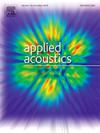Influence and optimization design of structure parameters on a giant magnetostrictive transducer
IF 3.4
2区 物理与天体物理
Q1 ACOUSTICS
引用次数: 0
Abstract
To design and obtain a giant magnetostrictive ultrasonic transducer (GMUT) composed of double Terfenol-D rods with the best vibration performance near the operating frequency 20 kHz, the influence of structure parameters on the vibration performance of the window-type of GMUT is simulated and analyzed. The calculation shows that as the length of the rod, the thickness of the permanent magnet, and the thickness of the magnetizer increase, the GMUT output amplitude firstly increases and then decreases; the GMUT amplitude increases as the increase of the window width (distance between two Terfenol-D rod axes). The window width has the greatest influence on the uniformity of the axial magnetic field inside the rod, while the influence of rod length, permanent magnet thickness, and magnetizer thickness decrease in sequence. The relationship between magnetic field uniformity, shear stress, and GMUT output amplitude is complicated, however, the shear stress and amplitude have certain optimal values. To achieve the best vibration performance of the transducer, it is appropriate to take the magnetizer thickness of 3–5 mm, the permanent magnet of 3–5 mm, the Terfenol-D rod length of 19–24 mm, and the window width of 65–67 mm. A prototype GMUT was fabricated for experimental testing. The maximum output was 6.1 μm at the excitation current of 1A.
求助全文
约1分钟内获得全文
求助全文
来源期刊

Applied Acoustics
物理-声学
CiteScore
7.40
自引率
11.80%
发文量
618
审稿时长
7.5 months
期刊介绍:
Since its launch in 1968, Applied Acoustics has been publishing high quality research papers providing state-of-the-art coverage of research findings for engineers and scientists involved in applications of acoustics in the widest sense.
Applied Acoustics looks not only at recent developments in the understanding of acoustics but also at ways of exploiting that understanding. The Journal aims to encourage the exchange of practical experience through publication and in so doing creates a fund of technological information that can be used for solving related problems. The presentation of information in graphical or tabular form is especially encouraged. If a report of a mathematical development is a necessary part of a paper it is important to ensure that it is there only as an integral part of a practical solution to a problem and is supported by data. Applied Acoustics encourages the exchange of practical experience in the following ways: • Complete Papers • Short Technical Notes • Review Articles; and thereby provides a wealth of technological information that can be used to solve related problems.
Manuscripts that address all fields of applications of acoustics ranging from medicine and NDT to the environment and buildings are welcome.
 求助内容:
求助内容: 应助结果提醒方式:
应助结果提醒方式:


